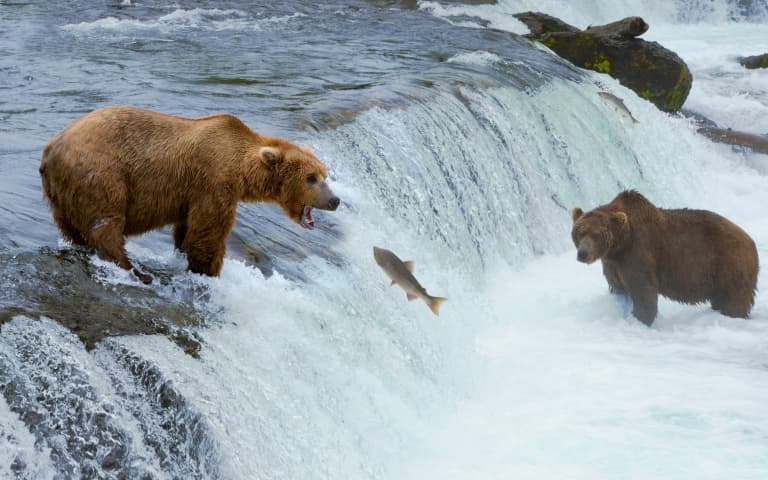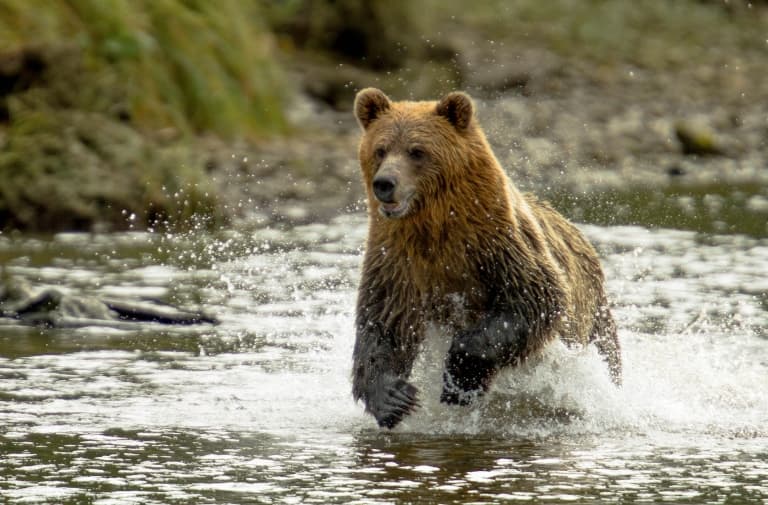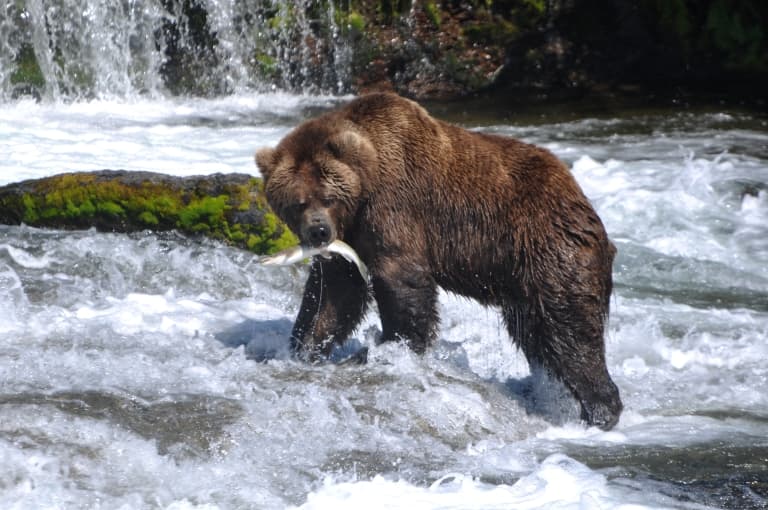Grizzly Bear Profile
Grizzly bears (Ursus arctos horribilis) are a subspecies of the brown bear (Ursus arctos) found in inland Northern America.
They are famous for their large size, weighing up to 360kg, and their often aggressive nature.

Grizzly Bear Facts Overview
| Habitat: | Forests, alpine meadows, prairies, and often prefer to be around rivers. |
| Location: | Northern America (especially Alaska and Canada) |
| Lifespan: | 20-25 years |
| Size: | 198 cm (6.50ft) on average |
| Weight: | Females: 130-180kg (290-400lb), 180-360 kg (400-790lb) |
| Color: | Brown |
| Diet: | Large mammals (caribou and bison), carrion, fish, berries, clams etc. |
| Predators: | None |
| Top Speed: | 56 km/h (30 mph) |
| No. of Species: |
1 |
| Conservation Status: |
Threatened under US law, but least concern according to the IUCN |
They are apex predators, hunting large prey such as caribou, but they are also very opportunistic. They will eat carrion (already dead animals), salmon, berries and even clams. Their strong front legs are adapted both for running fast to catch prey, and for digging and foraging.
They are primarily solitary, except for mothers with cubs. However, as many as 20 individuals can come together to hunt salmon that are moving upstream to spawn.
Females live for around 26 years, which is longer than males who live for around 22 years on average.
Interesting Grizzly Bear Facts
1. They are a subspecies of the brown bear.
Grizzly bears are considered a subspecies of the brown bear (Ursus arctos). The main difference between them is in diet and geography. Brown bears are mainly coastal with access to marine foods, whereas grizzlies live further inland. 1
2. They are called “grizzly” both for their fur and their nature.
Their hair is grizzled, meaning silver tipped. However, it is believed they originally got their name after the word “grisly” meaning gruesome or scary.
Their scientific classification ‘Ursus arctos horribilis‘ was also named after their ‘horrifying’ reputation by a natuaralist in 1815. 2
3. They are apex predators.
This means they are at the top of the food chain. They hunt large mammals, such as moose, caribou, and bison, using their speed and strength to catch them.
4. Grizzly bears are also very opportunistic eaters.
They’ll also eat carrion (things that are already dead), forage for berries, dig into sand for razor clams, eat grass, and go fishing in rivers.
5. They come together to hunt salmon.
Every year grizzlies gather to fish for the salmon that are swimming upstream to spawn. As many as 20 can be seen in one spot, where they often catch salmon leaping out of the water with their paws.
6. They are huge.
Average length of grizzly bears is around 2 metres, with females weighing 130-180kg and males 180-360kg. However, some huge males grizzlies have been reported to stand as high as 3 metres (9.8 ft) and weighing up to 680kg!
7. They have a distinctive hump on their back.
This hump is actually a large muscle which controls their forearms.

8. Grizzlies claws are as long as human fingers.
They are up to 4 inches long.
9. They can run at 30 miles (56kmp) an hour.
Despite their large size, they can move fast. The large hump on their shoulders powers their fast-moving front legs. This is why they tell you if you bump into a grizzly, don’t try and run from it! 3

10. They hibernate for 5-7 months every year.
They’re well known for their hibernating habits. Bears will dig large dens which they curl up in to sleep for the coldest months of the year. However, bears in sunny California don’t hibernate as it’s not needed.
11. They give birth while hibernating.
Female grizzly bears give birth while hibernating. The grizzly cubs will stay in the den drinking milk until the end of winter. 4
12. They don’t become pregnant straight away.
Via a process of “delayed implantation”, embryos are stored until the mother has gained enough weight for hibernation.
13. They eat a lot of food before they hibernate.
They don’t eat while they’re hibernating, so they eat as much food as possible beforehand. Bears can gain as much as 180kg (400lb) in weight before going into hibernation.

14. Grizzly bears don’t pee or poop during hibernation.
Throughout the whole of the 5-7 months they don’t go to the bathroom. They are actually able to turn excess urea (a component of urine) back into protein, meaning they actually gain muscle while hibernating.
15. Mama bears are fierce.
Mothers with young cubs will be very protective of their young, including fighting off larger male bears.
16. They will nurse their cubs for up to 3 years.
A mother will keep her cubs with her for as many as three years.
17. They need a lot of space.
Grizzlies in general range over large areas, as much as 1500 square km (~600 square miles). Males have large territories, which females roam through.
18. They are more dangerous to humans than sharks.
While sharks get all the media attention, bear attacks on humans are actually more common and numbers are actually on the rise.
However, grizzly bears normally avoid contact with people and rarely actively hunt humans. Many of these attacks occur when people accidentally stumble upon mother bears with cubs.
The rise in attacks is thought to be due to growing human use of grizzly bear habitat, and ‘problem bears’ who have associated humans with having potential ‘food’ near to them. 5
19. Grizzlies and wolves are competitors.
In places where the two overlap, like Yellowstone Park, they often compete fiercely over food.
20. They are a conservation success story.
Human expansion into grizzly habitat led to huge numbers in their decline, however after they were declared protected by the law in the USA, their numbers have bounced back. 6
Grizzly Bear Fact-File Summary
Scientific Classification
| Kingdom: | Animalia |
| Phylum: | Chordata |
| Class: | Mammalia |
| Order: | Carnivora |
| Family: | Ursidae |
| Genus: | Ursus |
| Species Name: |
Ursus Arctos Horribilis |
Fact Sources & References
- National Park Service. Brown Bear Frequently Asked Questions – Katmai National Park & Preserve. Accessed January 14, 2021.
- Cener for Biological Diversity. Natural history. Accessed January 14, 2021.
- How do these big, boxy creatures with flat feet run so fast? | College of Agricultural, Human, and Natural Resource Sciences | Washington State University. Accessed January 14, 2021
- “Hibernation-Migration-Fascination” Narrative – Glacier National Park (U.S. National Park Service). Accessed January 14, 2021.
- Bombieri G, Naves J, Penteriani V, et al. Brown bear attacks on humans: a worldwide perspective. Sci Rep. 2019;9(1):1-10. doi:10.1038/s41598-019-44341-w
- Defenders of Wildlife. Grizzly Bear | Defenders of Wildlife. Accessed January 14, 2021
